| کد مقاله | کد نشریه | سال انتشار | مقاله انگلیسی | نسخه تمام متن |
|---|---|---|---|---|
| 4559087 | 1628397 | 2016 | 9 صفحه PDF | دانلود رایگان |

• Dual-species cold biofilms were more tolerant to chitosan, despite lower counts.
• Lm persistent-strain tolerance to chitosan was unaffected by Pseudomonas' presence.
• Pseudomonas was crucial for Lm non-persistent-strain recovery at low temperature.
• Structural damages induced by chitosan differed in warm and cold biofilms.
• Recovery pattern after chitosan treatment differed in warm and cold biofilms.
The persistence of certain Listeria monocytogenes (Lm) strains in the food industry is a concerning food safety issue. Most of the studies that link persistence with other features, such as biofilm (BF) formation and tolerance to antimicrobials, are conducted at different temperatures from those generally used in food facilities. In this work, two Lm strains, one persistent and one sporadic, plus the reference strain Scott A were cultivated either alone or with Pseudomonas fluorescens (Pf) to form BF at 20 °C or 4 °C. In both systems, the ability of Lm cells to recover after chitosan treatment was evaluated. Structural changes after chitosan exposure and over the revitalization period were analysed using confocal laser scanning microscopy (CLSM). More Lm cells per surface unit were attained in binary BF formed at room temperature, though in those formed under refrigeration, higher tolerance to chitosan was observed. Whereas the persistent Lm strain recovered from chitosan damage at almost the same rate with or without Pf, the presence of this accompanying species was crucial for non-persistent Lm strain recovery, especially at those BF formed at 4 °C. The temperature at which BF were formed, influenced the morphology of the lesions caused by chitosan, as well as the time profile of Lm's viability recovery, suggesting that cold stress increases the tolerance to this antimicrobial, either through structural BF modification, or in some other way. These findings are relevant to the design of realistic BF control strategies in food industry, where most products are handled under refrigerated conditions.
Journal: Food Control - Volume 65, July 2016, Pages 143–151